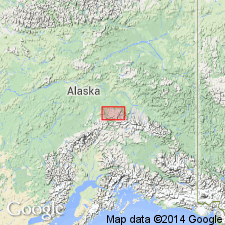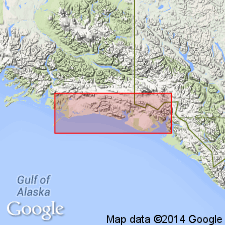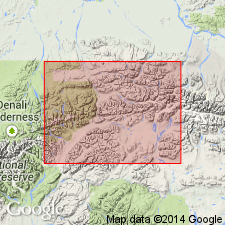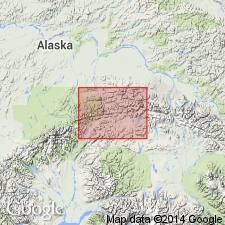
- Usage in publication:
-
- Healy Creek Formation*
- Modifications:
-
- Named
- Biostratigraphic dating
- Dominant lithology:
-
- Sandstone
- Claystone
- Conglomerate
- Coal
- AAPG geologic province:
-
- Alaska East-Central region
Summary:
Named from Healy Creek. Type section designated as exposure on northeast wall of canyon of Healy Creek at Suntrana, SW/4 sec.4 T12S R7W, Healy D-4 quad, east-central AK. Reference section designated at east end of Healy Creek syncline about 6.5 mi east of type section. Is probably most widely distributed of coal-bearing group in Nenana coal field. Consists of interbedded poorly consolidated sandstone, conglomerate, claystone, and subbituminous coal. Thickness ranges from 800 to 1150 ft. Unconformably overlies pre-Tertiary rocks; conformably underlies Sanctuary Formation (new). Based on "lower Healy Creek" (or Rex Creek) flora and "upper Healy Creek" floral assemblages age is considered late(?) Oligocene to early Miocene, although type locality is early Miocene age only.
Source: GNU records (USGS DDS-6; Menlo GNULEX).

- Usage in publication:
-
- Healy Creek Formation*
- Modifications:
-
- Age modified
- AAPG geologic province:
-
- Alaska East-Central region
- Alaska Southern region
Summary:
Healy Creek Formation shown on correlation chart as Angoonian and early Seldovian plant Stages (late Oligocene and early Miocene age).
Source: GNU records (USGS DDS-6; Menlo GNULEX).

- Usage in publication:
-
- Healy Creek Formation*
- Modifications:
-
- Revised
- Age modified
- AAPG geologic province:
-
- Alaska East-Central region
- Alaska Southern region
Summary:
Healy Creek Formation assigned as lowermost formation (of 5) to Usibelli Group (new). At Suntrana age is early and middle Miocene. Therefore, overall age is late Oligocene to middle Miocene on basis of [reinterpreted age for] plant fossils.
Source: GNU records (USGS DDS-6; Menlo GNULEX).

- Usage in publication:
-
- Healy Creek Formation*
- Modifications:
-
- Age modified
- AAPG geologic province:
-
- Alaska East-Central region
- Alaska Southern region
Summary:
Unit age revised from late Oligocene to middle Miocene to: late Eocene and early and middle Miocene based on reinterpretation of ages of plant fossils [Rex Creek assemblage = late Eocene] and recognition of major hiatus within unit spanning entire Oligocene (and part of late Eocene) time. [see also Wolfe and Tanai (1986, Journal of Faculty of Science, Hokkaido University, ser.4 v.22 no.1)]
Source: GNU records (USGS DDS-6; Menlo GNULEX).
For more information, please contact Nancy Stamm, Geologic Names Committee Secretary.
Asterisk (*) indicates published by U.S. Geological Survey authors.
"No current usage" (†) implies that a name has been abandoned or has fallen into disuse. Former usage and, if known, replacement name given in parentheses ( ).
Slash (/) indicates name conflicts with nomenclatural guidelines (CSN, 1933; ACSN, 1961, 1970; NACSN, 1983, 2005, 2021). May be explained within brackets ([ ]).

